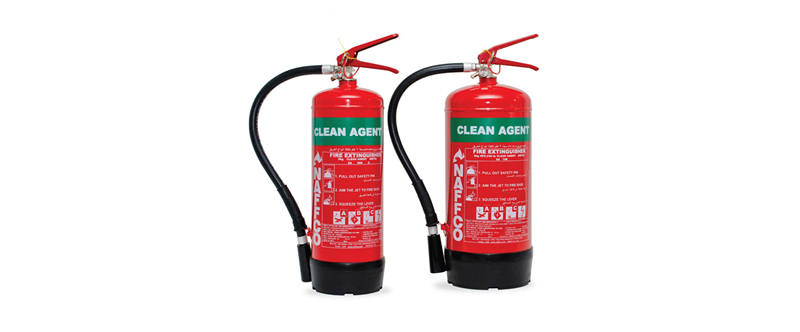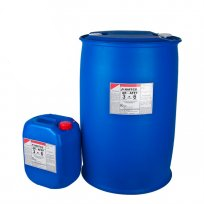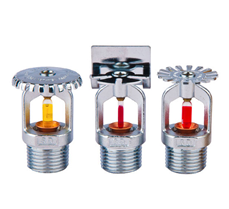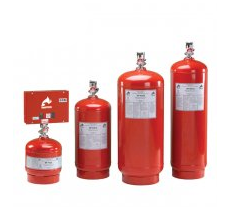Fire Systems Ltd. offers a range of fire suppression systems that are designed to protect your property, equipment, and personnel from the hazards of fire. Among these systems is the FM 200 fire suppression system, which is an environmentally friendly alternative to Halon 1301.

FM 200 fire suppression systems work by flooding an area with a gas that suppresses fire. The FM 200 gas is non-toxic, non-corrosive, and leaves no residue, making it safe for people and equipment. This makes it a popular choice for computer rooms, data centers, telecommunications facilities, museums, and art galleries, where water-based fire suppression systems would cause more damage than the fire itself.
In addition to FM 200 systems, we offer a range of other fire suppression systems, including:

CO2 System: Effective Fire Suppression Solution
CO2 systems are one of the most effective and widely used fire suppression solutions available today. CO2, or carbon dioxide, is a colorless, odorless gas that is stored in cylinders and released through nozzles to extinguish fires. It works by displacing oxygen in the air and smothering the fire.
At Fire Systems Ltd., we offer a range of CO2 systems for various applications, including industrial, commercial, and marine. Here are some key features of our CO2 systems:
- High-Quality Components: Our CO2 systems are designed and manufactured using high-quality components that meet international standards. We only use components from trusted brands to ensure the reliability and durability of our systems.
- Customizable Design: We can customize the design of our CO2 systems to meet the specific needs of our clients. We take into account factors such as the type of facility, the size of the area to be protected, and the type of hazards present when designing and installing the system.
- Efficient Suppression: CO2 systems are highly effective at suppressing fires, especially in enclosed spaces where other methods may not be as effective. They can quickly extinguish fires and prevent re-ignition.
- Minimal Residue: Unlike other fire suppression solutions, CO2 leaves no residue after use. This means that cleanup and restoration after a fire is minimal, reducing downtime and costs associated with the fire.
- Easy Maintenance: Our CO2 systems are designed for easy maintenance and servicing. Regular maintenance and inspection ensure that the system is in good working condition and ready to use in case of an emergency.

Clean Agent FE-227 System
The Clean Agent FE-227 system is a fire suppression system designed to protect sensitive equipment and valuable assets from fire damage while minimizing the impact on the environment. This system uses a clean agent, FE-227 (heptafluoropropane), which is a colorless, odorless, and electrically non-conductive gas that leaves no residue after discharge.
How it Works:
When a fire breaks out, the Clean Agent FE-227 system detects it through the smoke or heat detectors and activates the fire alarm. The system then releases the clean agent gas into the protected area through strategically placed nozzles. The FE-227 gas extinguishes the fire by removing heat from the combustion process, preventing re-ignition and minimizing damage to the protected area.
Benefits:
- Fast Fire Suppression: The Clean Agent FE-227 system is designed to suppress fires quickly and effectively, helping to minimize damage to equipment and property.
- Environmental Friendly: The Clean Agent FE-227 system is an environmentally friendly fire suppression system, as it does not release any harmful substances or residues into the environment.
- Non-Corrosive: The clean agent FE-227 gas does not react with the metal, plastic, or electrical components of the protected area, reducing the risk of damage to equipment or property.
- Safe for Occupants: The Clean Agent FE-227 system is safe for human occupants as it does not displace oxygen in the protected area.
Applications:
The Clean Agent FE-227 system is ideal for protecting data centers, server rooms, control rooms, archives, museums, and other facilities where valuable and sensitive equipment is stored.
Components:
The Clean Agent FE-227 system includes the following components:
- Clean Agent FE-227 storage cylinders
- Distribution piping network
- Control panel
- Smoke or heat detectors
- Alarm system
- Nozzles
Maintenance:
Regular maintenance of the Clean Agent FE-227 system is crucial to ensure that it is always in optimal condition. Our team of trained technicians at Fire Systems Ltd. can provide maintenance services to ensure that the system is always ready to respond in case of a fire emergency.
The Clean Agent FE-227 system is a highly effective and environmentally friendly fire suppression system that can protect sensitive equipment and valuable assets while minimizing damage to property. At Fire Systems Ltd., we provide installation, maintenance, and commissioning services for the Clean Agent FE-227 system to ensure that our clients receive the best fire protection solutions for their needs.

Foam Equipment and Concentrates
Foam fire suppression systems are ideal for protecting high-risk areas such as airports, refineries, and petrochemical plants. They work by smothering the fire, preventing oxygen from reaching the fuel source. Foam equipment and concentrates are an essential component of these systems, and Fire Systems Ltd. offers a wide range of products to meet your needs.
Types of Foam Concentrates:
There are two primary types of foam concentrates: Aqueous Film-Forming Foam (AFFF) and Protein-Based Foam. AFFF is the most common type of foam concentrate used in fire suppression systems due to its effectiveness against Class B fires (flammable liquids and gases) and Class A fires (wood, paper, and textiles). Protein-Based Foam is more effective against Class B fires and is commonly used in the food and beverage industry due to its non-toxic properties.
Foam Equipment:
Foam equipment is the delivery system used to apply the foam concentrate to the fire. Fire Systems Ltd. offers a wide range of foam equipment, including foam nozzles, foam chambers, foam monitors, and foam proportioners. Foam proportioners are particularly important as they ensure that the correct amount of foam concentrate is mixed with water, allowing for optimal fire suppression.
Foam Storage:
Foam concentrate must be stored properly to ensure it remains effective. Fire Systems Ltd. offers foam concentrate storage tanks in various sizes, allowing for the proper storage and dispensing of foam concentrate.
Maintenance and Training:
Regular maintenance and training are essential to ensuring that foam fire suppression systems are effective when needed. Fire Systems Ltd. provides comprehensive maintenance and training services to ensure that your system is always in optimal condition and that your team is prepared to handle a fire emergency.

Sprinkler System
Sprinkler systems are an effective and reliable means of fire protection in a variety of settings, including commercial, industrial, and residential buildings. Fire Systems Ltd. is proud to offer a range of high-quality sprinkler systems that are designed to help safeguard people, property, and assets against the damaging effects of fire.
What is a Sprinkler System?
A sprinkler system is a fire suppression system that is designed to detect and extinguish fires quickly and effectively. It consists of a network of pipes that are filled with water, and strategically placed sprinkler heads that are designed to spray water in the event of a fire. When a fire is detected, the sprinkler system is activated, and water is automatically released from the sprinkler heads to extinguish the fire.
Types of Sprinkler Systems:
- Wet Pipe Sprinkler System: This type of sprinkler system is the most common and consists of pipes that are filled with pressurized water. When a fire is detected, the sprinkler heads open, allowing water to flow onto the fire.
- Dry Pipe Sprinkler System: This type of sprinkler system is designed for use in areas that are at risk of freezing. The pipes are filled with pressurized air, and when a fire is detected, the sprinkler heads open, allowing the air to escape and water to flow onto the fire.
- Deluge Sprinkler System: This type of sprinkler system is designed for use in areas where fires can spread quickly, such as chemical storage facilities. The system is always filled with water, and when a fire is detected, all of the sprinkler heads open at once, drenching the entire area with water.
Advantages of Sprinkler Systems:
- Early detection and extinguishing of fires
- Reduces damage to property and assets
- Can prevent the spread of fire to adjacent areas
- Provides a safe evacuation path for occupants of the building
- Can help reduce insurance premiums for building owners

Kitchen Hood System
Fire Systems Ltd. is pleased to offer high-quality kitchen hood systems to our customers in Uganda. We understand the importance of protecting commercial kitchens from fire risks, which is why we have a range of reliable and effective kitchen hood systems available.
What is a Kitchen Hood System?
A kitchen hood system is a fire suppression system designed specifically for commercial kitchens. These systems work by detecting and suppressing fires that may occur on cooking equipment and in exhaust ductwork. They are an essential component of any commercial kitchen’s fire protection plan.
How Does a Kitchen Hood System Work?
A typical kitchen hood system consists of several components, including a control panel, detection system, and suppression agent. When a fire is detected, the system activates, shutting down fuel and electrical sources to cooking equipment and discharging a suppression agent onto the affected area.
Types of Kitchen Hood Systems:
- Wet Chemical Kitchen Hood System: This type of system uses a wet chemical agent that is discharged from nozzles above the cooking equipment. The wet chemical agent reacts with the grease and oil that fuel the fire, creating a soapy foam that smothers the flames.
- Dry Chemical Kitchen Hood System: A dry chemical system uses a powder-based extinguishing agent that is discharged from nozzles above the cooking equipment. The powder works by interrupting the chemical reaction of the fire.
- Pre-Engineered Kitchen Hood System: Pre-engineered systems are designed to be easy to install and maintain. These systems come with pre-configured components and are designed to meet the specific needs of the kitchen they are installed in.
Advantages of Kitchen Hood Systems:
- Quick Response Time: Kitchen hood systems are designed to detect and suppress fires quickly, reducing the risk of injury to employees and minimizing property damage.
- Easy to Install: Pre-engineered kitchen hood systems are designed to be easy to install, which means that they can be up and running quickly, reducing downtime for your kitchen.
- Cost-Effective: Installing a kitchen hood system can help you avoid costly fire damage, insurance claims, and potential lawsuits.
Conclusion:
If you own or operate a commercial kitchen in Uganda, a kitchen hood system is a critical component of your fire protection plan. At Fire Systems Ltd., we offer a range of high-quality kitchen hood systems to meet your needs. Our expert technicians can help you select the right system for your kitchen, and we offer installation and maintenance services to ensure that your system is always working properly. Contact us today to learn more.
